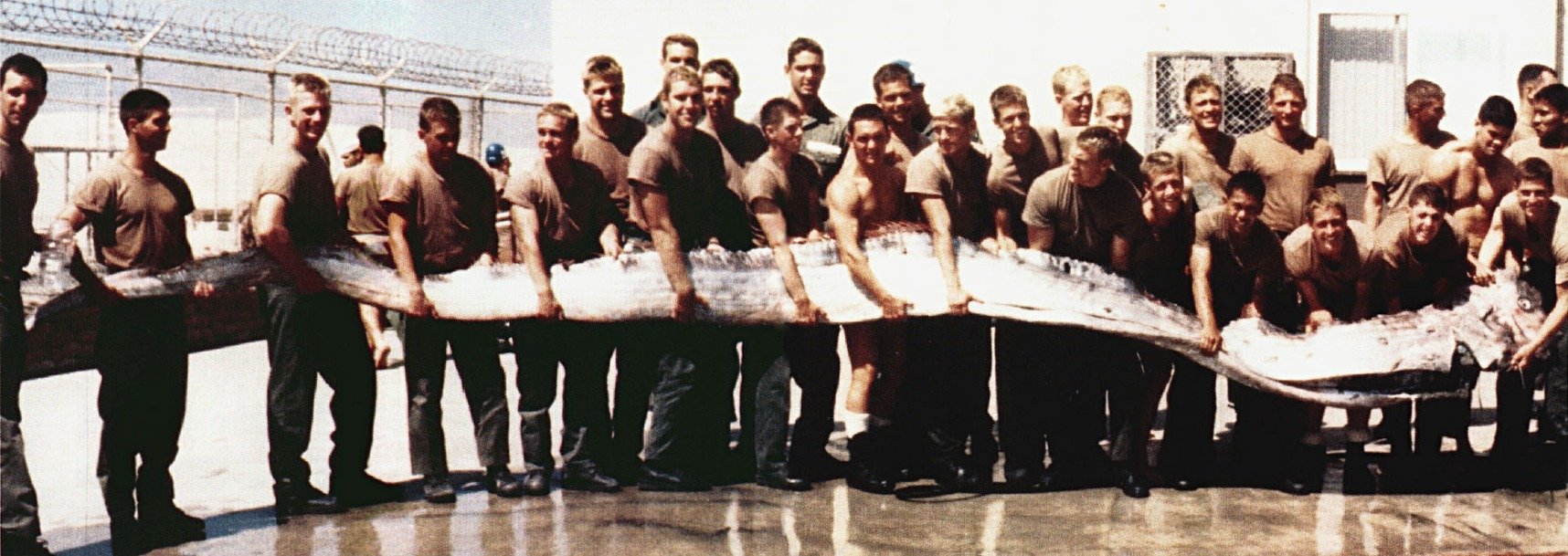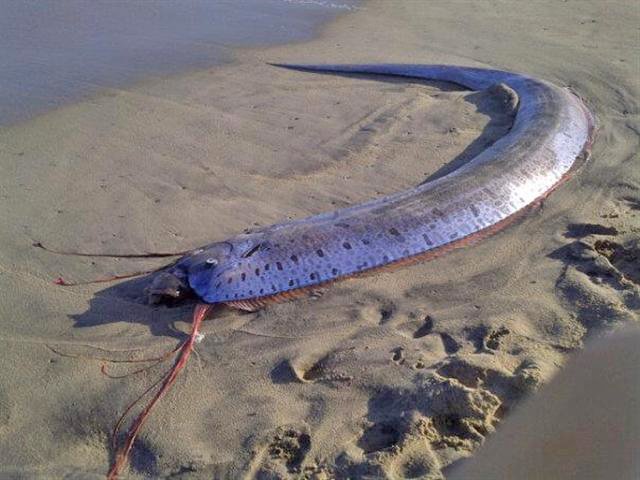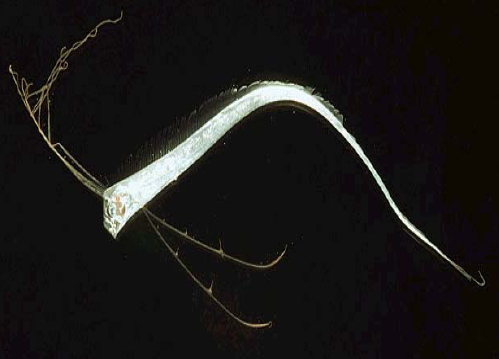Welcome to another post of my strange animals series where you get to meet some of the weirdest, coolest, and craziest animals on a daily basis!
Today's post is about the King of herrings, one of the most horrifying monsters lurking in the deep blue! Don't be scared though, looks can be deceiving!
 US Navy Seals display a 23-foot (7 m) giant oarfish (credit, public domain)
US Navy Seals display a 23-foot (7 m) giant oarfish (credit, public domain)
Scientifically described as Regalecus glesne, the king of herrings is a gentle giant that will leave you unharmed if you ever happen to encounter it. Some other common names this magnificent creature comes by include giant oarfish, ribbonfish, and streamer fish.
Now, let's learn more about this horrid deep sea monster!
Damn, it looks huge! How big does it get?
It looks and it is huge! The king of herrings actually holds the record for world's longest bony fish, reaching a maximum verified length of at least 11 m (36 ft)! However, there have been unconfirmed reports of individuals measuring up to 17 m (56 ft) long.
The heaviest ever recorded specimen was about 270 kilos (600 lb).
Where can I find one?
Are you asking because you want to see one? Or to avoid it at all costs?
Well, first the good news (or bad, depending your perspective). The species has a worldwide distribution, occurring in the Atlantic and Pacific oceans as well as the Mediterranean Sea, with confirmed sightings from England to New England to Brazil and from Japan to New South Wales, Australia. Sightings seem to be more common in oceans with tropical to temperate waters. [2]
Now the bad news. Your chances of ever seeing one from up close are slim to none. This is a deep sea creature that likes to chill in the mesopelagic zone, in depths ranging from 200 to 1000 meters. Individuals rarely come close to the surface and very few people have actually seen one alive. Most of the recorded sightings are actually from dead or sick individuals that got washed out or surfaced to leave their dying breaths.

Regalecus glesne found in Los Cabos, Baja California Sur, Mexico (credit, CC BY 3.0 )
What does it eat?
The species feeds on small stuff, like crustaceans, squids, jellyfish and zooplankton.
How about humans? Does it eat humans ?
Rest assured, there is nothing to be afraid of. as the creature has a tiny, toothless mouth. But to be honest, I would still shit myself if I ever saw one swimming next to me.
How does it spend its life?
Unfortunately, this is a very poorly understood species and we know very little about its behavioral and reproductive patterns. Adults appear to live a solitary life coming together only to reproduce.
Females lay eggs that float at the surface from July to December. These eggs are 2 to 6 mm in diameter and........ that's pretty much all we know about their life-cycle! Since the giant oarfish belongs to Lampriformes, we assume that it takes about 3 weeks for the eggs to hatch but nothing is certain.
Another thing we can say with certainty is that sharks and Lancetfish prey on them as we have found pieces of them in the stomachs of the latter.

Juvenile specimen (credit, public domain)
Is it threatened?
Very little is known about the size and health of the species' populations. However, we assume it's not under immediate threat thanks to its worldwide distribution.
The end
That's pretty much all we know about this majestic animal. I will close this article with some quick facts that I think are interesting along with another video showcasing the creature. If you like reading about boring technicalities, I suggest you to visit the links in the references. But if you just want to know the basics I think I got you covered!
See you in my next strange animals post!
 (credit, CC BY-SA 4.0)
(credit, CC BY-SA 4.0)
Some Quick & Interesting Facts
- The species was first described by Norwegian biologist, Peter Ascanius in 1772.
- The genus name, "Regalecus", signifies "belonging to a king", while the specific epithet "glesne" is from "Glesnaes", the name of a farm at Glesvær near where the type specimen was found.
- Don't be fooled by the common name. The king of herrings is not closely related to herrings!
- Most of the vital organs are located near the head. Scientists assume that this helps them survive losing large parts of their body.
- Regalecus glesne should not be confused with Agrostichthys parkeri, commonly known as the Streamer fish, a very similar looking oarfish of the same family (Regalecidae), found in the southern oceans. The two are easily distinguished from the number of gill rakers in the mouth. The giant oarfish has around 50 whereas the Streamer has about 10.
Also I want to thank @datboithe1 for sharing this interesting fact: "The "king of herrings" is so named because it was once believed that it swam in front of the herring shoals, as if leading them." [5]
References & Further Reading
- Wikipedia.org/wiki/Giant_oarfish
- Eol.org/pages/225594/details#distribution
- Iucnredlist.org/details/190378/0
- Fishbase.se/summary/Regalecus-glesne.html
- Texassaltwaterfishingmagazine.com/fishing/education/fishy-facts/king-herrings

My dear readers, thank you for reading today's article. Hopefully, you found it interesting enough to follow me, @trumpman, for more weird and bizarre creatures from all around the word! If you like strange animals as much as I do, here are the last 3 weirdos of this series:
- Slimy Jewels: 11+1 Nudibranchs That Will Blow Your Mind
- Cebrennus rechenbergi: The Spider That Wanted To Be A Gymnast
- Beauty Stings: The Stinging Rose Moth Caterpillar
- Pacific Barreleye: Meet the Fish With the Transparent Head!
- Phrynosoma Hernandesi: Meet the Lizard That Shoots Blood From Its Eyes!
Steemstem & Steemit Education
Interested in science? Please, don't forget to check the @steemstem project, a community-driven project meant to promote well-written, high-quality, STEM-related content (STEM as for Science, Technology, Engineering and Mathematics). Just click here to join us! And for those engaging with education, @steemiteducation is here to join all steemian educators in their common cause of making the job easier, more effective and more fun!
Greek Community
A big thanks goes to my fellow greeks who support me with their love! You guys rock! A special mention also goes to @rouketas and @skapaneas for bringing us all together! I love you guys all :)



